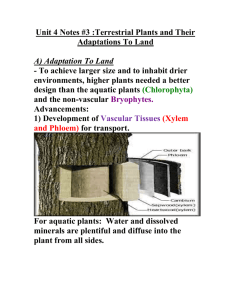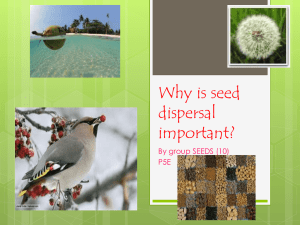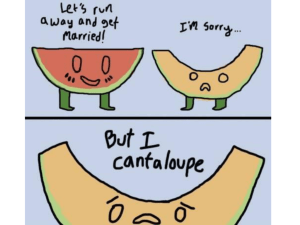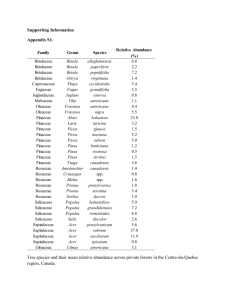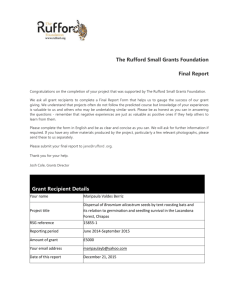Fruit formation and dispersal QA
advertisement
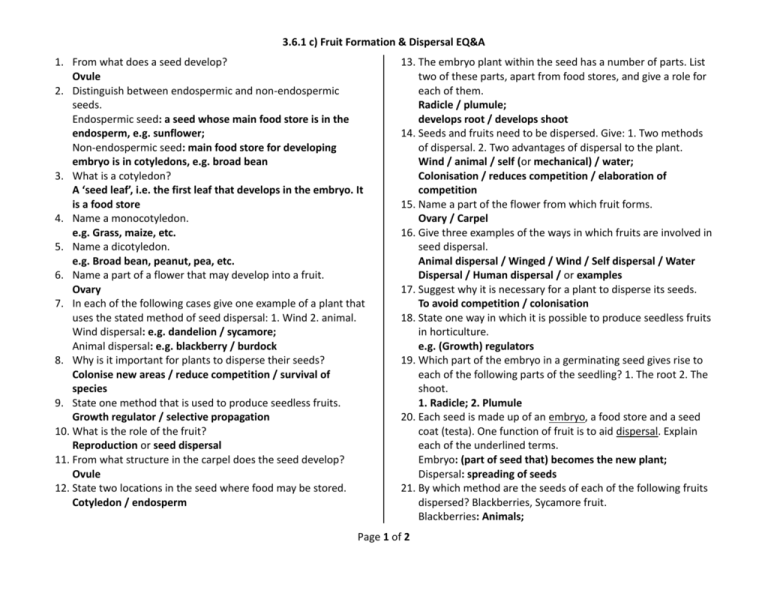
3.6.1 c) Fruit Formation & Dispersal EQ&A 1. From what does a seed develop? Ovule 2. Distinguish between endospermic and non-endospermic seeds. Endospermic seed: a seed whose main food store is in the endosperm, e.g. sunflower; Non-endospermic seed: main food store for developing embryo is in cotyledons, e.g. broad bean 3. What is a cotyledon? A ‘seed leaf’, i.e. the first leaf that develops in the embryo. It is a food store 4. Name a monocotyledon. e.g. Grass, maize, etc. 5. Name a dicotyledon. e.g. Broad bean, peanut, pea, etc. 6. Name a part of a flower that may develop into a fruit. Ovary 7. In each of the following cases give one example of a plant that uses the stated method of seed dispersal: 1. Wind 2. animal. Wind dispersal: e.g. dandelion / sycamore; Animal dispersal: e.g. blackberry / burdock 8. Why is it important for plants to disperse their seeds? Colonise new areas / reduce competition / survival of species 9. State one method that is used to produce seedless fruits. Growth regulator / selective propagation 10. What is the role of the fruit? Reproduction or seed dispersal 11. From what structure in the carpel does the seed develop? Ovule 12. State two locations in the seed where food may be stored. Cotyledon / endosperm 13. The embryo plant within the seed has a number of parts. List two of these parts, apart from food stores, and give a role for each of them. Radicle / plumule; develops root / develops shoot 14. Seeds and fruits need to be dispersed. Give: 1. Two methods of dispersal. 2. Two advantages of dispersal to the plant. Wind / animal / self (or mechanical) / water; Colonisation / reduces competition / elaboration of competition 15. Name a part of the flower from which fruit forms. Ovary / Carpel 16. Give three examples of the ways in which fruits are involved in seed dispersal. Animal dispersal / Winged / Wind / Self dispersal / Water Dispersal / Human dispersal / or examples 17. Suggest why it is necessary for a plant to disperse its seeds. To avoid competition / colonisation 18. State one way in which it is possible to produce seedless fruits in horticulture. e.g. (Growth) regulators 19. Which part of the embryo in a germinating seed gives rise to each of the following parts of the seedling? 1. The root 2. The shoot. 1. Radicle; 2. Plumule 20. Each seed is made up of an embryo, a food store and a seed coat (testa). One function of fruit is to aid dispersal. Explain each of the underlined terms. Embryo: (part of seed that) becomes the new plant; Dispersal: spreading of seeds 21. By which method are the seeds of each of the following fruits dispersed? Blackberries, Sycamore fruit. Blackberries: Animals; Page 1 of 2 3.6.1 c) Fruit Formation & Dispersal EQ&A Sycamore fruit: Wind: Wind 22. After fertilisation, what part of the flower becomes the fruit? Ovary 23. Many seedless fruits, e.g. grapes, are available in shops today. State one way of forming seedless fruits. Genetic engineering / growth regulators / hormones / selective breeding 24. As the seed forms following fertilisation, a food store develops in one of two structures. Name any one of these structures. Endosperm or cotyledon (or seed leaf or embryonic leaf) 25. After fertilisation, what part of the flower becomes the fruit? Ovary 26. Give two methods of seed dispersal in plants. Wind / Animal / Self 27. Why is it necessary for plants to disperse their seeds? To avoid competition or to avail of suitable conditions Page 2 of 2




